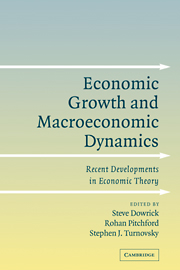Book contents
- Frontmatter
- Contents
- Preface
- Contributors
- PART ONE TOPICS IN GROWTH THEORY
- 1 Growth and the Elasticity of Factor Substitution
- 2 Relative Wealth, Catching Up, and Economic Growth
- 3 Knowledge and Development: A Schumpeterian Approach
- PART TWO STATISTICAL ISSUES IN GROWTH AND DYNAMICS
- PART THREE DYNAMIC ISSUES IN INTERNATIONAL ECONOMICS
- Index
3 - Knowledge and Development: A Schumpeterian Approach
Published online by Cambridge University Press: 31 October 2009
- Frontmatter
- Contents
- Preface
- Contributors
- PART ONE TOPICS IN GROWTH THEORY
- 1 Growth and the Elasticity of Factor Substitution
- 2 Relative Wealth, Catching Up, and Economic Growth
- 3 Knowledge and Development: A Schumpeterian Approach
- PART TWO STATISTICAL ISSUES IN GROWTH AND DYNAMICS
- PART THREE DYNAMIC ISSUES IN INTERNATIONAL ECONOMICS
- Index
Summary
INTRODUCTION
It is easy to get discouraged when pondering the economic situation of the world's poorest countries. The large-scale international development programs that have been under way for the past half century have fallen short of solving the problems of disease, malnutrition, illiteracy, and poverty that keep people in less developed countries (LDCs) from enjoying the prosperity we take for granted in the industrialized world. In terms of per capita real income, which is arguably the best single indicator of a country's level of economic development, the gap between rich and poor has been growing exponentially. For example, in 1960 the average per capita real income of the richest 10% of countries was more than 12 times that of the poorest 10%. Since then the average income of the richest 10% has tripled, while that of the poorest 10% has remained roughly constant.
Economics provides no magic formula for closing the development gap: that is why our discipline is known as the dismal science. However, in this chapter we shall argue that the task is not as impossible as it might a priori seem: reflecting on how technology has rescued people from economic difficulties in the past provides at least reason to believe that the prospects of low-income countries in the 21st century are somewhat brighter than one might otherwise think and to gain faith in the growth-enhancing effects of policies aimed at facilitating the creation and the diffusion of technological knowledge.
A main lesson from the history of the past two centuries is that salvation has often come in the form of new technological knowledge.
- Type
- Chapter
- Information
- Economic Growth and Macroeconomic DynamicsRecent Developments in Economic Theory, pp. 46 - 80Publisher: Cambridge University PressPrint publication year: 2004
- 1
- Cited by

